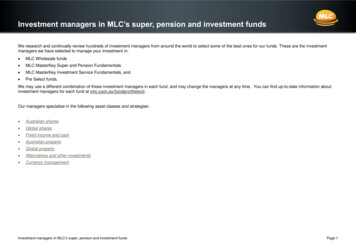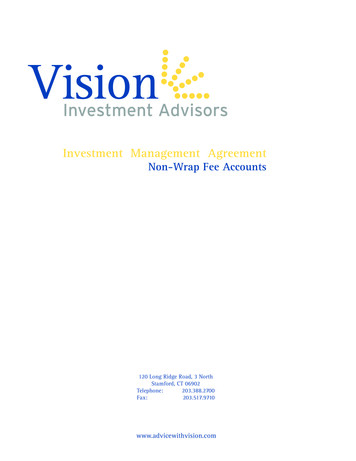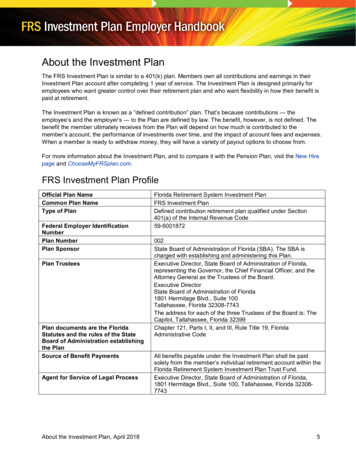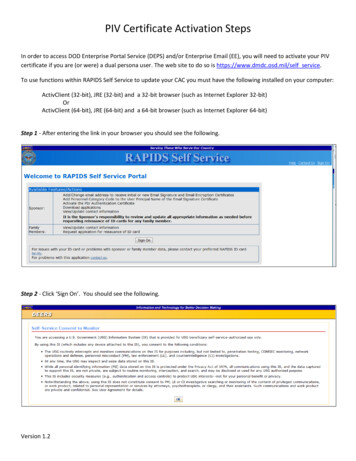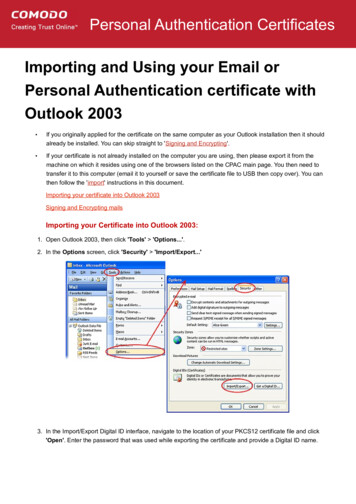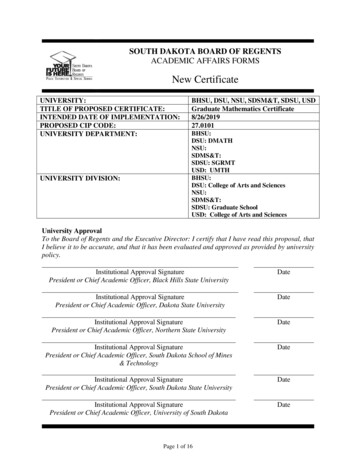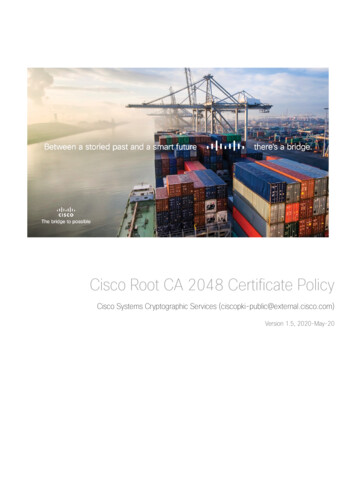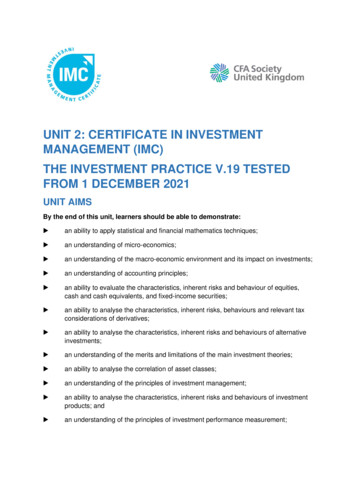
Transcription
UNIT 2: CERTIFICATE IN INVESTMENTMANAGEMENT (IMC)THE INVESTMENT PRACTICE V.19 TESTEDFROM 1 DECEMBER 2021UNIT AIMSBy the end of this unit, learners should be able to demonstrate: an ability to apply statistical and financial mathematics techniques; an understanding of micro-economics; an understanding of the macro-economic environment and its impact on investments; an understanding of accounting principles; an ability to evaluate the characteristics, inherent risks and behaviour of equities,cash and cash equivalents, and fixed-income securities; an ability to analyse the characteristics, inherent risks, behaviours and relevant taxconsiderations of derivatives; an ability to analyse the characteristics, inherent risks and behaviours of alternativeinvestments; an understanding of the merits and limitations of the main investment theories; an ability to analyse the correlation of asset classes; an understanding of the principles of investment management; an ability to analyse the characteristics, inherent risks and behaviours of investmentproducts; and an understanding of the principles of investment performance measurement;
QUESTION ALLOCATION:Question allocation across the syllabus is balanced on the guidance of psychometric and industryspecialists. The following question allocation for Version 19 of the IMC is provided as a broadindication of the relative ‘weighting’ of different parts of the syllabus in IMC examinations from 1December 2021.Content areaTopicTopic nameQuestionallocationQuantitative7Quantitative ics10Accounting11Equities12Fixed income13Derivatives14Alternative investments and privatemarkets15Portfolio management16Investment products17Investment performance measurementEconomicsAccountingAsset classes5–1510–2025–30Investment theory,management andmeasurement25–30OTHER INFORMATION REGARDING THIS UNIT:Exam format:105 questions.Online testing using standard multiple choice, item sets and gap-fill stylequestions.Time allowed for exam:2 hours and 20 minutes.Grades:Pass or fail.Study materials:Official Training Manual v.19 is available from the CFA UK website, includingrevision questions with fully worked calculations.Mock exam available on the CFA UK website.Recommended study hours:120 hours.Availability of exam sessions:Every working day through Pearson VUE testing centres and every day viaOnVUE remote proctoring.
TOPIC 7 QUANTITATIVE METHODSBy the end of this topic, learners should be able to: Demonstrate an ability to apply statistical and financial mathematics techniques.7.1SOURCES OF DATA7.1.1Identify and distinguish between different sources and types of data7.1.2Distinguish between a population and a sample7.1.3Explain the key sampling methods7.1.4Distinguish between continuous and discrete data7.1.5Define categorical data and explain how it can be converted to ordinal data7.1.6Interpret a frequency and relative frequency distribution7.1.7Explain the use of the following in the presentation of data: pie chart, bar chart,histogram, scatter plots and line graphs7.2SUMMARY DATA7.2.1Define, explain and calculate the arithmetic mean, geometric mean, median andmode using raw and interval data, and calculate the geometric mean return using aseries of returns7.2.2Explain the relationship between the mean, median and mode for symmetric andskewed data7.2.3Define, explain and calculate the following measures of dispersion for both raw dataand interval data: standard deviation (population and sample), variance, range,quartiles and percentiles, and interquartile range7.2.4Explain the notion of probability distributions and identify the properties of the normaldistribution7.2.5Explain and apply the concepts of null hypothesis, alternative hypothesis and the roleof statistical significance in rejecting/accepting the null/alternative hypotheses in thecontext of investment decision-making7.3CORRELATION AND BIVARIATE LINEAR REGRESSION7.3.1Define correlation and identify alternative measures of correlation7.3.2Explain the least-squares regression technique in deriving a line of best fit andinterpret the correlation coefficient R, R squared, adjusted R squared and measuresof unexplained variation (for example the mean squared error)7.3.3Calculate and interpret a forecast value for the dependent variable given the interceptand slope coefficients of a regression equation taking into account their statisticalsignificance and adjusted R squared7.3.4Explain the shortfalls in the application of linear regression to forecasting, includingwhy correlation does not imply causation, and the pitfalls of data-mining
7.3.5Describe the impact of extreme events on alternative measures of correlation7.4INDEX NUMBERS7.4.1Explain the role of financial market indices7.4.2Explain and calculate a price relative for a share or index and calculate an index levelfor the current year, given the base year data and the current year data7.4.3Calculate an index level having re-based the index series7.4.4Calculate a price-weighted index, an equally weighted index, a market valueweighted index and a geometrically weighted index7.4.5Identify and explain the impact of a free float adjusted versus pure marketcapitalisation methodology on index calculation7.4.6Describe the composition and construction of key global bond and equity marketindices and identify strengths and weaknesses of their respective constructionmethods7.5SIMPLE AND COMPOUND INTEREST7.5.1Calculate simple and compound interest earned over multiple periods7.5.2Calculate the annual compound rate given the simple rate and the frequency ofcompounding7.5.3Calculate the annual simple rate of interest given the annual compound rate and thefrequency of compounding7.5.4Calculate the effective annual rate given a nominal annual rate with continuouscompounding7.6THE TIME VALUE OF MONEY – PRESENT AND FUTURE VALUECALCULATIONS, ANNUITIES, PERPETUITIES AND MORTGAGES7.6.1Calculate and interpret future values for single sums and annuities7.6.2Calculate and interpret present values for single sums, annuities, and perpetuities7.6.3Calculate equal instalments on a repayment mortgage given the present value of theborrowings, the fixed mortgage rate and the term of the borrowing7.7THE INTERNAL RATE OF RETURN AND NET PRESENT VALUE7.7.1Calculate and interpret the net present value (NPV) and internal rate of return (IRR)of a series of investment cash flows7.7.2Explain how NPVs and IRRs can be used in investment decision making and theirlimitations
TOPIC 8 MICRO-ECONOMICSBy the end of this topic, learners should be able to: Demonstrate an understanding of micro-economics.8.1INTRODUCTION TO MICRO-ECONOMICS8.1.1Explain the main ways in which economic theory might assist investmentprofessionals8.1.2Describe the strengths and weaknesses of economic theory as a means of analysingfinancial market behaviour8.1.3Describe the main applications of micro-economic theory8.2ANALYSING DEMAND AND SUPPLY8.2.1Explain the laws of supply and demand and the concept of equilibrium8.2.2Distinguish between movements along demand and supply curves, and shifts thereof8.2.3Identify the factors that cause a demand or supply schedule to shift8.2.4Describe, calculate and interpret ‘own price elasticity of demand’, the factors thatdetermine this and its impact on total revenues8.2.5Explain, calculate and interpret the concept of cross elasticity of demand (as appliedto substitute and complementary goods)8.2.6Explain, calculate and interpret the concept of income elasticity8.3ANALYSING COST AND PROFITABILITY8.3.1Distinguish between explicit (accounting) costs and opportunity (economic) costs8.3.2Explain the concept of normal, supernormal and subnormal levels of profit8.3.3Define fixed costs, variable costs, marginal costs, total costs and average costs8.3.4Explain the shapes of the short-run marginal cost, average variable cost, averagefixed cost and average total cost curves8.3.5Explain the law of diminishing marginal returns and its impact on the shape of shortrun cost curves8.3.6Explain the relationship between total revenue, average revenue and marginalrevenues for a normal demand schedule8.3.7Explain the relationship between marginal cost and marginal revenue, and how thisdetermines the profit-maximising level of output for a firm8.3.8Define short run and long run in the context of cost behaviour8.3.9Explain the notions of economies of scale, a minimum efficient scale anddiseconomies of scale and their impact on the shape of the long-run average costcurve8.3.10 Explain the relationship between long-run marginal costs and long-run average costsand explain how this determines the level of output for productive efficiency to arise
8.4ANALYSING THE COMPETITIVE ENVIRONMENT8.4.1Identify the conditions that characterise a perfectly competitive (price-taker) market8.4.2Explain the conditions of long-run equilibrium for a price-taker8.4.3Explain the market mechanics through which only normal levels of profit can beearned by price-takers in the long run8.4.4Explain the relationship between short-run supply and marginal cost for a price-taker8.4.5Describe the shape of the long-run supply curve for a perfectly competitive industry8.4.6Explain the decision by a price-taker facing economic losses to either continue tooperate or shut down8.4.7Explain, calculate and interpret elasticity of supply and its dependence on theflexibility of factors of production8.4.8Identify the conditions that characterise a pure monopoly8.4.9Distinguish between the equilibrium price, output levels and productive efficiency of amonopoly compared to a perfectly competitive firm8.4.10 Explain price discrimination and the conditions under which it will prevail8.4.11 Describe the characteristics of monopolistic competition and oligopoly8.4.12 Describe how business cycles may affect relative industry performance8.4.13 Identify Porter’s five competitive forces that drive industry competition8.4.14 Describe the product life cycle and the characteristics of each phase (introduction,growth, maturity and decline)8.4.15 Describe the concept of strengths, weaknesses, opportunities and threats (SWOT)analysis and its role in corporate evaluation8.4.16 Describe the four Ps of marketing mix (product, price, promotion and place) in thecontext of analysing competitive advantage and threatsTOPIC 9 MACRO-ECONOMICSBy the end of this topic, learners should be able to: Demonstrate an understanding of the macro-economic environment and its impacton investments.9.1INTRODUCTION TO MACRO-ECONOMICS9.1.1Describe the main applications of macro-economic theory9.1.2Identify the key economic characteristics of historical financial crises9.2ANALYSING THE OUTLOOK FOR GDP GROWTH9.2.1Identify the main long-term UK and global socio-economic trends9.2.2Identify the key economic indicators and their trends
9.2.3Describe the relationship between, and importance of, the main world economies9.2.4Describe economic and financial cycles including their predictability and regionaldifferences9.2.5Distinguish between gross domestic product (GDP), gross national product (GNP)and national income9.2.6Identify the difference between real and nominal GDP9.2.7Identify the components of the circular flow of income, distinguishing betweeninjections into and withdrawals (‘leakages’) from the circular flow9.2.8Identify the nature of the relationship between aggregate saving, consumption andinvestment as predicted by the Paradox of Thrift9.3ANALYSING ECONOMIC POLICY9.3.1Identify the major components of the Classical, Monetarist, Keynesian and Austrianschools of thought and distinguish between them9.3.2Describe fiscal policy and its influence on aggregate demand9.3.3Identify the problems associated with fiscal policy9.3.4Identify money supply (from ‘narrow’ through to ‘broad’)9.3.5Identify the key features of the fractional reserve banking system9.3.6Define the money multiplier and identify its determinants9.3.7Calculate the potential money multiplier given a cash reserve ratio9.3.8Explain the transmission mechanism whereby monetary policy influences economicaggregates9.3.9Define unemployment and explain how it is measured in the UK9.3.10 Define inflation (including deflation), explain how it is measured in the UK and identifythe different causes9.3.11 Explain the relationship between inflation and unemployment according to the Phillipscurve9.3.12 Explain how inflation targeting operates in the UK9.3.13 Distinguish between the different mandates and approaches of the major centralbanks9.3.14 Explain the unconventional tools used by central banks to manage the economy9.3.15 Explain the impact of bank capital and liquidity requirements and the move towardsmacro prudential regulation of the macro-economy9.3.16 Identify the role of debt in the business cycle9.4ANALYSING EXCHANGE RATES9.4.1Explain how changes in supply and demand for a currency will affect its value on theforeign exchange markets
9.4.2Identify the key components of the balance of payments9.4.3Explain the relationship between the supply and demand for a currency, and theunderlying transactions represented in the balance of payments9.4.4Distinguish between a fixed, floating and a managed exchange rate (‘dirty floating’regime)9.4.5Explain the economic benefits and costs of a fixed exchange rate mechanism9.4.6Explain the implications of persistent global imbalances of trade and capital9.4.7Explain the notion of purchasing power parity (PPP) as a forecasting tool forexchange rates9.4.8Explain the effectiveness of monetary and fiscal policy in fixed and floating exchangerate regimes9.4.9Explain an optimal currency area (OCA) and identify the advantages anddisadvantages of implementing a single currency in an OCA9.4.10 Describe the nature and basic operations of the spot and forward exchange markets9.4.11 Explain the nature of exchange rate risk and how it can be managed9.4.12 Apply the concept of PPP to forecast expected future spot exchange rates using thedifferential inflation rates between two countries9.4.13 Distinguish between covered and uncovered interest rate parity and calculateforward rates using the appropriate methodTOPIC 10 ACCOUNTINGBy the end of this topic, learners should be able to: Demonstrate an understanding of accounting principles.10.1FUNDAMENTAL PRECEPTS10.1.1 Explain the legal requirement to prepare financial statements10.1.2 Define ‘small companies’ for the purpose of financial statement preparation andexplain the relevance of this definition to financial reporting requirements10.1.3 Explain the concept of a company being a separate legal entity, and the purpose ofthe preparation of the accounts10.1.4 Explain when accounts may be required to be prepared under International FinancialReporting Standards (IFRS) rather than Generally Accepted Accounting Principles inthe UK (UK GAAP)10.1.5 Explain the role of the auditor and identify, in outline, the reasons for auditors issuinga qualified report10.2THE BALANCE SHEET10.2.1 Explain the purpose of a balance sheet or statement of financial position
10.2.2 Identify and explain the key balance sheet categories and content10.2.3 Distinguish between capitalising costs and expensing costs10.2.4 Explain the valuation of non-current assets10.2.5 Calculate depreciation under the straight-line and reducing balance methods10.2.6 Calculate the profit or loss on disposal of a non-current asset10.2.7 Explain the principles behind the valuation of inventories10.2.8 Explain the effects of first-in-first-out and last-in-first-out valuations on inventoryvalues and profits10.2.9 Identify the types of current and non-current liabilities that typically appear in financialstatements10.2.10 Explain the concept of a provision and its treatment within the financial statements10.2.11 Explain the concept of a contingent liability and its treatment within financialstatements10.2.12 Describe the treatment of pension costs in financial statements10.2.13 Explain what is meant by a post-balance sheet event10.2.14 Distinguish among authorised, issued, paid-up and called-up share capital10.2.15 Explain the effect of the following on a balance sheet: rights issue, bonus/scripissue, stock split and share repurchases10.2.16 Identify and explain the main types of reserve found in the balance sheet10.3THE ACCOUNTING TREATMENT OF FINANCIAL INSTRUMENTS10.3.1 Identify the various classifications of financial instrument and describe the accountingtreatment of each10.4THE INCOME STATEMENT AND STATEMENT OF CHANGES IN EQUITY10.4.1 Identify and explain the classification of expenses based on nature or function10.4.2 Explain the principle of revenue recognition10.4.3 Identify the following different levels of profit and which classes of expenses areconsidered in arriving at each level: operating profit and net profit including theimplications of using non-statutory profit measures10.4.4 Explain the objective of, and identify the information to be reported in, a statement ofchanges in equity10.5THE CASH FLOW STATEMENT10.5.1 Explain the purpose of a cash flow statement10.5.2 Identify the classification of cash flow activities10.5.3 Calculate net cash flow from operations given operating profit (or vice versa) and therelevant balance sheet movements
10.6GROUP ACCOUNTS10.6.1 Define and distinguish between corporate investments, associated companies andsubsidiaries10.6.2 Explain the purpose of group accounts10.6.3 Define a minority interest and explain how it is represented in financial statements10.6.4 Explain how goodwill arises in acquisition accounting10.6.5 Explain the treatment of goodwill and intangible assets in the group accounts,including amortisation, useful lives and the requirement for impairment reviews10.7MAJOR ACCOUNTING RATIOS10.7.1 Distinguish between profitability, liquidity and gearing ratios10.7.2 Define and calculate return on capital employed and return on equity ratios10.7.3 Explain how return on capital employed can be broken down into profit margin andasset turnover10.7.4 Define, calculate and interpret operational gearing, financial gearing, the current ratioand the quick ratio (acid test)10.7.5 Explain the effect of the following on the major accounting ratios: rights issue,bonus/scrip issue, stock split and share repurchasesTOPIC 11 EQUITYBy the end of this topic, learners should be able to: Demonstrate an ability to evaluate the characteristics, inherent risks and behaviour ofequities.11.1EQUITY CAPITAL – CHARACTERISTICS11.1.1 Identify the characteristics, and the risks to the investor, of the various classes ofequity capital11.1.2 Identify the reasons for primary issuance and secondary markets for ordinary shareswith investor implications11.1.3 Identify the reasons for issuance of preference shares and the implications to theinvestor11.1.4 Identify the characteristics of global and American Depository Receipts11.2EQUITY – ISSUANCE AND CAPITAL RETURN11.2.1 Distinguish between primary and secondary share issuance11.2.2 Define the key features of an equity issuance11.2.3 Define and explain the purpose of a rights issue, a bonus/scrip issue and a stock split11.2.4 Calculate the theoretical ex-rights price and the value of the right (nil-paid) given thecum-rights price, the issuance ratio and the subscription price
11.2.5 Evaluate the options open to an investor in response to a rights offer and explain theeffect on the investor’s wealth11.2.6 Calculate the theoretical ex-scrip price given the scrip ratio and the cum-scrip price11.2.7 Identify and explain the motivations behind a company buying back its own shares11.3EQUITY – VALUATION11.3.1 Calculate a holding period return for an ordinary share, comprising capital gain anddividend income11.3.2 Identify the reasons for a company’s chosen dividend policy11.3.3 Explain the practical constraints on companies paying dividends11.3.4 Explain the importance of the dividend yield and dividend cover in stock analysis11.3.5 Calculate dividend yield and dividend cover11.3.6 Calculate an estimated growth rate for dividends using historic data, or using returnon equity, and a retained earnings ratio11.3.7 Identify the components, assumptions and limitations of the dividend discount model(Gordon growth model)11.3.8 Calculate the present value of a share using the dividend discount model11.4EQUITY – ALTERNATIVE VALUATION METRICS11.4.1 Distinguish between and evaluate the merits of relative valuation models andabsolute valuation models, and between historic and prospective measures of value11.4.2 Explain what is meant by earnings per share and diluted earnings per share11.4.3 Calculate a basic earnings per share11.4.4 Explain the possible shortfalls of using price multiples in corporate valuation11.4.5 Calculate price to earnings (both historic and prospective), price to book, price tosales, price to cash flow, and enterprise value to earnings before interest, tax anddepreciation and amortisation (EBITDA) ratios for a company11.4.6 Explain the basics of free cash-flow based valuation methods (FCFF and FCFE) andresidual income valuation methods11.4.7 Define financial gearing and evaluate the effect on required equity returns and thusvaluationsTOPIC 12 FIXED INCOMEBy the end of this topic, learners should be able to: Demonstrate an ability to analyse the characteristics, inherent risks, and behaviour ofcash and cash equivalents, and fixed-income securities.
12.1CASH AND CASH EQUIVALENTS12.1.1 Explain the main characteristics and risks associated with cash deposits and moneymarket instruments (including Treasury Bills, certificates of deposit (CDs),commercial paper (CP) and floating rate notes (FRNs))12.1.2 Calculate the discount and quoted yield on a UK Treasury Bill12.2FIXED-INCOME SECURITIES – CHARACTERISTICS12.2.1 Explain the structure and characteristics of the various types of fixed-incomeinstruments issued in the UK, including government bonds, index-linked bonds,corporate bonds and Eurobonds12.2.2 Calculate the price of a fixed income security given its maturity, coupon and yield12.2.3 Explain clean (quoted) and dirty pricing12.2.4 Identify the rationale for and risks to the issuer and holder of a convertible, callable orputtable bond12.3FIXED-INCOME SECURITIES – RISK AND RETURN12.3.1 Identify the components of return of the present value calculation12.3.2 Identify the main risks faced by bond holders and how these risks can be addressed12.3.3 Identify the nature of the relationship between yield and price12.3.4 Identify the two components of interest rate risk (price and reinvestment risk)12.3.5 Analyse the factors that affect the sensitivity of a bond’s price to a change in requiredyield12.3.6 Define and calculate the (Macaulay) duration of a bond12.3.7 Define and calculate the modified duration of a bond12.3.8 Calculate, given the duration of a bond, the change in price given a change inrequired yield12.3.9 Explain the convexity error that arises from using duration to estimate a change inbond price using duration12.3.10 Define credit risk as it affects bonds12.3.11 Identify the role and drawbacks of the major credit rating agencies12.3.12 Interpret the key classes of rating on the scales published by the major ratingagencies12.3.13 Explain the concept of debt seniority12.3.14 Identify key features and financial ratios considered by credit rating agencies inconducting a corporate rating12.4FIXED-INCOME SECURITIES – YIELDS AND THE YIELD CURVE12.4.1 Define and calculate flat yield, gross redemption yield (GRY), net redemption yield(NRY) and grossed-up NRY
12.4.2 Explain when each of these measures may be appropriate to use12.4.3 Define the yield curves12.4.4 Explain the theories that contribute to explaining the shape of the yield curve12.4.5 Define and calculate forward and spot interest rates12.4.6 Explain the relationship between forward rates, spot rates and the GRYTOPIC 13 DERIVATIVESBy the end of this topic, learners should be able to: Demonstrate an ability to analyse the characteristics, inherent risks and behavioursof derivatives.13.1DERIVATIVES13.1.1 Distinguish between forwards, futures and options13.1.2 Explain the nature, trading and settlement of exchange-traded derivatives13.1.3 Identify the motive for using a futures contract rather than a trade in the underlyingasset13.1.4 Explain the nature of, and reasoning behind, a contango and backwardation market13.1.5 Define the ‘basis’ of a futures contract13.1.6 Describe the main features of the following ICE Futures Europe contracts: short-terminterest rate futures, long gilt futures and FTSE 100 futures13.1.7 Explain the possible uses of the above contracts in an investment managementcontext13.1.8 Define the concept of index arbitrage13.1.9 Distinguish between American-style and European-style options13.1.10 Differentiate between the time value and intrinsic value components of an optionpremium13.1.11 Determine when an option is in-the-money, out-of-the-money or at-the-money13.1.12 Calculate the time value of an option, given the premium, strike price and currentmarket price13.1.13 Explain the use of futures and options in hedging an equity portfolio13.1.14 Calculate the number of futures or options contracts required to hedge a portfoliowith a specified beta value13.1.15 Identify and explain the factors that determine the premium of an option13.2SELLING SHORT, STOCK LENDING AND CONTRACT FOR DIFFERENCES(SWAPS)13.2.1 Explain the role of stock lending in the markets and the benefits to the participants
13.2.2 Explain the mechanics and uses of short selling13.2.3 Explain the nature of contracts for differences13.2.4 Explain the nature of, and motivations behind, interest rate swaps, currency swaps,equity swaps and inflation swaps13.3CONVERTIBLES AND WARRANTS13.3.1 Explain the nature of convertible bonds and convertible preference shares13.3.2 Calculate a conversion price, conversion value and conversion premium13.3.3 Explain the component parts of the valuation of a convertible bond (namely straightbond value, call option value, dilution effect and conversion ratio)13.3.4 Distinguish between a warrant and a call option13.3.5 Explain the key features of covered warrants13.4CREDIT DERIVATIVES13.4.1 Identify the main purposes, mechanics, and implications of a credit default swap(CDS)13.4.2 Identify the main risks to the financial system resulting from credit derivativesTOPIC 14 ALTERNATIVE INVESTMENTS AND PRIVATE MARKETSBy the end of this topic, learners should be able to: Demonstrate an ability to analyse the characteristics, inherent risks and behavioursof alternative investments.14.1ALTERNATIVE INVESTMENTS, PRIVATE MARKETS AND PORTFOLIODIVERSIFICATION14.1.1 Describe the main features and risks of alternative investments andtheir increasing role as a diversifier in portfolios.14.2COMMODITIES INCLUDING CRYPTOCURRENCIES14.2.1 Describe the main features of commodity markets14.2.2 Identify the main ways investors can access the commodity markets14.2.3 Explain the characteristics of the main commodity and emission derivatives, includingenergy, metals, softs/biofuels and carbon emissions14.2.4 Explain the characteristics and risks of investing in precious metals14.2.5 Identify the main commodity derivative indices14.2.6 Explain how commodity exposure can be viewed as a hedge against inflation and‘event’ risk14.2.7 Explain the role and main features of cryptocurrencies
14.3PROPERTY14.3.1 Explain the rationale for investing in property and contrast the investmentcharacteristics of property with the other major asset classes14.3.2 Distinguish between the commercial and residential property markets14.3.3 Describe the role and challenges of using indices when measuring property returns14.3.4 Identify the main investors in the commercial property market and the characteristicsof the principal commercial property sectors14.3.5 Explain how the direct commercial property market works with regard to ownershipand lease structures, buying and selling, costs, the valuation of property andinvestment performance measurement14.3.6 Describe the main valuation techniques applied to property investment14.3.7 Identify the role of sustainability and environmental, social and governance (ESG)characteristics in property valuation and investment14.3.8 Explain the routes to indirect property investment14.4HEDGE FUND AND PRIVATE (UNLISTED) ASSETS14.4.1 Explain the features and objectives of hedge funds and funds of hedge funds14.4.2 Describe the various hedge fund strategies14.4.3 Identify the potential benefits and limitations of hedge funds14.4.4 Describe the management fee structure for hedge funds and unlisted asset investing14.4.5 Describe the various approaches to unlisted asset investing14.4.6 Identify the potential benefits and limitations of unlisted asset investingTOPIC 15 PORTFOLIO MANAGEMENTBy the end of this topic, learners should be able to: Demonstrate an understanding of the merits and limitations of the main investmenttheories. Demonstrate an ability to analyse the correlation of asset classes. Demonstrate an understanding of the principles of investment management.15.1RISK AND RETURN AND THE IMPORTANCE OF DIVERSIFICATION15.1.1 Explain the ‘normal’ trade-off between risk and return, and the concept of‘dominance’ between investment strategies15.1.2 Explain the importance of risk measurement in the analysis of investments, and whyex-ante and ex-post measures of risk may be very different15.1.3 Identify the commonly used measures of risk in investment analysis and fundmanagement
15.1.4 Explain the advantages and disadvantages of standard deviation as a measure ofrisk15.1.5 Explain the implications of assuming that returns are normally distributed15.1.6 Explain the meaning of value at risk (VaR) and its advantages and disadvantages forrisk management15.1.7 Explain the meaning of drawdown and its advantages and disadvantages as ameasure of ris
7.4.2 Explain and calculate a price relative for a share or index and calculate an index level for the current year, given the base year data and the current year data 7.4.3 Calculate an index level having re-based the index series 7.4.4 Calculate a price-weighted index, an equally weighted index, a market value-


